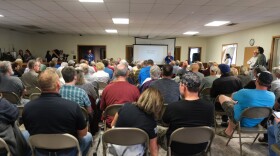PFAS, also called forever chemicals, have been found in drinking water, lakes, and the soil in parts of Oneida County.
While homeowners in the Stella area have been digging new wells and installing filtration systems to remove the PFAS from their drinking water, the major question remains of how to get the chemicals out of the environment.
Dr. Yanna Liang says PFAS remediation is going to change greatly from site to site with solutions tailored to specific situations.
“What I tell people is, there are solutions, but again, it's going to be site specific,” said Liang. “Traceability study is needed to prove at a small scale that it is going to work. Then once you have that proof of concept, and then you can scale it up to treat the whole site.”
Liang is a professor and chair of the Department of Environmental and Sustainable Engineering at the University of Albany. Her main area of research is on remediating site of contamination, like PFAS.
Lessons learned from DDT contaminations have given scientists a starting point for PFAS clean up, but that only goes so far.
“PFAS, some people say, is totally different beast. I would say, yeah, it is very, very difficult to work with,” said Liang.
The same components that make PFAS great for non-stick products make them extremely resistant to degradation.
Not to mentioned there are thousands of these chemicals that all have different chemical formula.
“If you want to destroy all of them, I don't think one technology is capable of [that],” said Liang.
Using plants through phytoremediation has proven effective for pulling some types of PFAS from the soil.
“We have proven that phytoremediation is very effective for removing some type of PFAS. For example, short chain, not necessarily PFOA/PFOS. Long chain PFAS can be removed, but again, the uptake rate is not that so high compared to short chains, because they are bigger molecules,” said Liang.
Some research has found thermal desorption (applying high temperatures to the soil) has broken down some PFAS chemicals, but Liang says it’s very hard to scale up.
Liang says there’s also been promising research into different material that could be added to the soil to immobilize the PFAS—which she says may be a good solution for agricultural fields that are contaminated.
“We know PFOA/PFOS, they tend to stay in soil, so why not just leave them there, but then make them immobilized in the soil? We have been studying different materials we can amend to the soil,” said Liang. “These materials will bind to PFAS. The binding is so tight that PFOA/PFOS will not migrate to groundwater and will not go to the plants growing in the soil.”
Liang says short-term studies have proven effective, but long-term studies are still needed for this method.
EPA soil samples show high concentrations of the PFOA and PFOS in the Stella area.
The Wisconsin DNR has named the Rhinelander Papermill current and past owners responsible because of the PFAS chemicals it says was in the sludge the mill spread on the agricultural fields in the area.
Liang says while solutions to remediation are out there, she believes the better solution is develop chemicals and materials that are PFAS-free.
“I think as a society, we just need to learn from the historical lessons, and then to see how we should develop chemicals and materials in the future,” said Liang. “We have to be very, very cautious and mindful about the drawbacks of seemingly very useful chemicals so they could be useful in certain applications. But again, the environmental impact is something we need to know beforehand, before they are used at large scale.”











